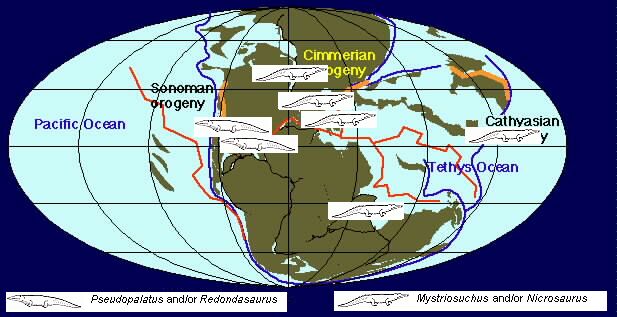
Distribution of Norian phytosaurs
map by Dr. Ron Blakey
| Late Triassic epoch | ||
| Mesozoic: Triassic Period |
Norian Age - 4 |
| Carnian | Middle Triassic | Norian 1 | ||
| Rhaetian | Early Jurassic | Timescale |

|
|
Distribution of Norian phytosaurs map by Dr. Ron Blakey |
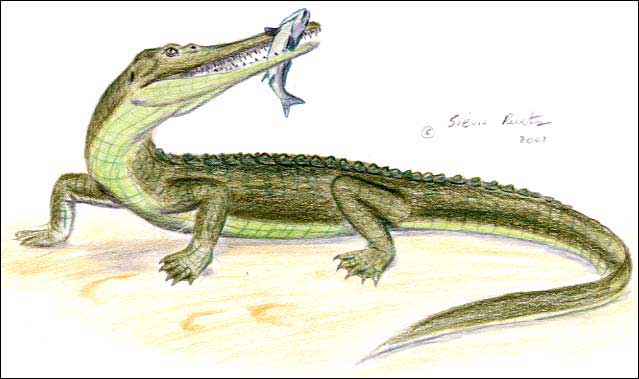 |
|
Illustration © copyright Silvio Renesto
|
Mystriosuchus was the most specialized of the long snouted phytosaurs; the Triassic equivalent (and probably precise ecological analogue) of the Tertiary to recent gavial. The skulls have a long, low, slender snout tipped with a pronounced spoon-like (hence the name "spoon crocodile") tusked "hook", and the teeth are all conical and similar in shape, indicating a fish-eating diet. Originally placed in its own subfamily, it is now known to be a specialized member of the subfamily Pseudopalatinae Hungerbühler, 2002. This was a large phytosaur, about 4 meters in length, and also one of the later forms to appear. Mystriosuchus is known from the Middle Stubensandstein (Middle Norian) of south-west Germany, Calcari di Zorzino of Northern Italy, and the Huai Hin Lat Formation of Thailand, and so can serve as useful index fossil. Significantly, it is absent from North America, showing that very different fauna lived in west Pangea from central and East Pangea. Two species are known, Mystriosuchus planirostris, illustrated above, and Mystriosuchus westphali (formerly Mystriosuchus plieningeri), although there may very well be more in non-European localities.
Mystriosuchus - Dr Silvio Renesto.
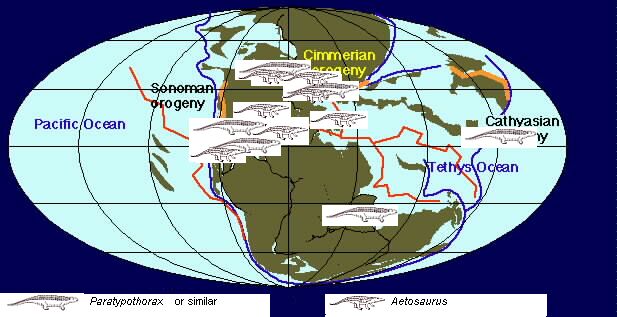
|
|
Distribution of the cosmopolitan Norian aetosaurs Paratypothorax and Aetosaurus map by Dr. Ron Blakey |
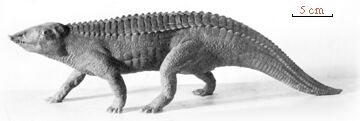
|
The armoured Stagonolepidae (Aetosaurs) continue to flourish during the earlier part of the Norian, and are prominently represented by the eponymous Aetosaurus, a small but heavily armoured animal 0.7 to 1.5 metres in length. Aetosaurus is actually among the most primitive of the Aetosaurs (and probably qualifies for its own subfamily). At least two species are known. Being a prominent and widespread animal of the middle Norian of the central and east Laurasian (northwest to middle north Pangea) biogeographic region, and the with distinctive armour, Aetosaurus makes a useful index fossil. The American species was previously considered a separate genus, Stegomus. Aetosaurs are unknown from the Late Norian of Europe, but related forms continued in the west of Pangea through the Rhaetian.
The cosmopolitan nature of these aetosaurs continues the theme of the Ardamanian (Latest Carnian) when Stagonolepis had what must have been a worldwide distribution. From central (middle Keuper) and north to west (upper Chinle) Laurasia, one finds the large very advanced turtle like Paratypothorax, and the persistently primitive little Aetosaurus. [Lucas et al 1996]
 |
|
illustration by M.Alan Kazlev Creative Commons License 2005
|
Teratosaurus suevicus has had a rather strange history of discovery. The jaws of this rauisuchian were originally found with sauropodomorph bones (belonging to the species Efraasia minor (Huene, 1907-08)). It was thought that these belonged to the same animal, and it was reconstructed as an early theropod. It is now known to be a rauisuchian [Benton 1986b], perhaps a Poposaurid. Despite the appearance of large podokesaurian-grade theropod dinosaurs, these animals continued to serve as the dominant predator in terrestrial ecologies. Unlike the theropods, they were not fast runners, and probably ambushed their prey with a sudden rush (like their distant living cousins the crocodiles).
Teeth found in the Lower Elliot formation of Southern Africa can also be attributed to Rauisuchians; they were originally given the name Basutodon ferox. Because they are found associated with the common sauropodomorph Euskelosaurus browni, it was originally thought that these prosauropods were carnivorous. This is now known not to be the case; a fragment of jaw was discovered bearing the same type of teeth, and associated with large postcranial elements and bony plates (osteoderms), and these remains most likely are rauisuchian [Kitching and Raath 1984 p.114]. Nevertheless, the name Basutodon is still given a junior synonym for Euskelosaurus
As evidenced by both the giant Gondwanan Fasalosuchus, and the central Laurasian [Newark Supergroup] ichnospecies Brachychirotherium parvum, Rauisuchians continued to flourish right until the end of the Rhaetian age.
"Postosuchus"-like form
Durham sub-basin of the Deep River basin (Newark Supergroup)
Durham County, North Carolina
Middle Norian
3 meters
Teratosaurus suevicus
middle Stubensandstein = Löwenstein Formation
south-west Germany.
Late Middle Norian
3 to 4 meters?
When I was a kid growing up, my books on dinosaurs, when describing the Triassic period, featured drawings and descriptions of small bipedal thecodonts, looking like miniature theropod dinosaurs. Subsequent research has shown that these pseudosuchian thecodonts were actually proto-crocodiles (although on the outside they look nothing like crocodiles!), and rather than being bipedal they ran rapidly on four lithe legs. From the Late Carnian (Adamanian Age) through to the Sinemurian, lightly built sphenosuchians were an important medium-small predators on microvertebrates and large invertebrates.
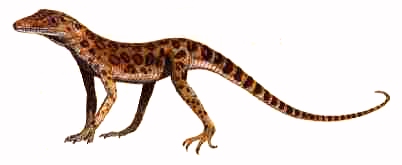 |
Terrestrisuchus gracilis illustration by Steve Kirk, © from Encyclopaedia of Dinosaurs and Prehistoric Animals, Barry Cox, R.J.G. Savage, Brian Gardiner, Dougal Dixon, |
It is not clear whether Terrestrisuchus gracilis from Anglo-Welsh fissure fillings, and Saltoposuchus connectens from the Stubenstein of Germany, are distinct but closely related forms, or simply growth stages of the same species [Clark et al 2000]. In any case, Hesperosuchus, Dromicosuchus, and Saltoposuchus/Terrestrisuchus form a tightly knit group. These slender animals were obviously very swift runners, and Terrestrisuchus, the best known and most illustrated (see above) has been described as "the greyhound of the Triassic". Clearly these animals competed with the podokesaurid theropods in the small predator niche, but inasmuch as the two groups lived quite happily side by side for some thirty million years or so, they must have filled different ecological niches.
The most recently discovered of these small crocodylomorphs, Dromicosuchus grallator [Sues et al 2003] was found preserved immediately underneath the skeleton of a rauisuchian, and this, along with apparent bite marks to the head and neck, indicate the two animals were buried together during the act of predation. It is however strange to imagine how a powerful rauisuchian can be killed in mortal combat with a lightly built sphenosuchid; a more likely explanation is that the two were killed and buried, perhaps by a sudden mudslide, just as the rauisuchian was dispatching its prey.
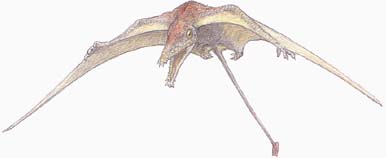 |
|
illustration copyright © Satoshi Kawasaki - original page
|
Like turtles, pterosaurs are one of those groups of animals that appear in the middle Norian, seemingly out of nowhere. Four species representing three families are known from the Upper strata of the Dolomia di Forni and the slightly later Calcari di Zorzino of Northern Italy (Late-Middle Norian Age), indicating that the group already had an earlier history, perhaps during the earlier Norian (apparent reports have Late Carnian Dockum Pterosaurs have not been confirmed).
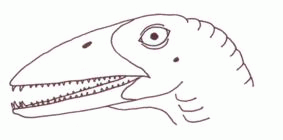 |
|
© 2001 Vince R Ward - Prehistoric Pages |
Peteinosaurus zambellii is the smallest (wingspan of about 60 cm) and most primitive of the early pterosaurs. The wings are quite short, only twice the length of the hind legs, and there are numerous small teeth which are flattened laterally, This animal probably fed on large insects, which it caught on the wing, cutting up the tough chitin with its small blade-like teeth. Only the skeleton and lower jaw are known, so the reconstruction of the head on the left is speculative, although not implausible given this shape is based on the similarly sized insect-eating Jurassic Anurognathid pterosaurs. Peteinosaurus appears related or ancestral to the Early Jurassic Dimorphodon, and is therefore placed in the family Dimorphodontidae.
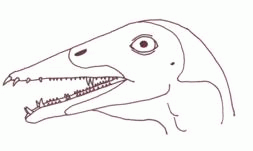 |
|
© 2001 Vince R Ward - Prehistoric Pages |
Eudimorphodon is so called because it has two types of teeth. The numerous small teeth have three or five cusps (points), a unique characteristic among Pterosaurs. There are also a number of larger, fang-like teeth. This was a largish pterosaur, with a wingspan of 1 to 1.75 meters. It was most likely a fish eater, like modern shore birds. The unusual teeth indicate that Eudimorphodon represented an early, specialized, evolutionary lineage. It is therefore given its own family: Eudimorphodontidae. This obviously common and widespread animal is known from the Norian of Greenland and Early Rhaetian of France as well as the late Middle Norian of Italy (Tethys)
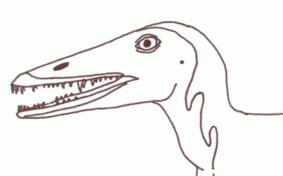
|
|
© 2001 Vince R Ward - Prehistoric Pages |
Preondactylus buffarinii is among the largest and most advanced of these early forms, with a wingspan of 1.5 meters, it belongs to the family Rhamphorhynchidae. It shares a number of characteristics with the Toarcian Dorygnathus.

|
|
drawing adapted from original © 2000 Vince R Ward - Prehistoric Pages |
Agnosphitys is a small herrerasaur, superficially similar in size and appearance to Scleromochlus, presumably living a similar lifestyle. It is also the last known herrerasaur. These primitive dinosaurs survived alongside their more advanced podokesaur descendents
Agnosphitys cromhallensis
60 cm
650 g
medium-sized insectivore/ microvertebrate predator.
Agnosphitys (in Japanese), Agnosphitys cromhallensis by Brad McFeeters (sketch)